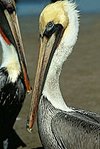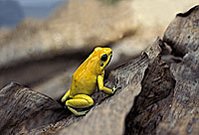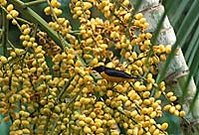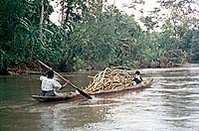Biological diversity in Tumbes-Chocó-Magdalena
Contents
Overview
Reaching from the most southeastern portion of Mesoamerica to the northwestern corner of South America, the Tumbes-Chocó-Magdalena Hotspot extends for 1500 kilometers and encompasses 274,597 km2 along the western coastal flank of the Andes mountains (Biological diversity in Tumbes-Chocó-Magdalena) . Formerly called the Chocó-Darién-Western Ecuador Hotspot, it has been expanded to include several new areas, notably the Magdalena Valley in northern Colombia.
From the Panama Canal, the hotspot extends south and east into the wet and moist forests of Panama's Darién Province, through the Chocó region of western Colombia and the moist forests along the west coast of Ecuador, and into the dry forests of eastern Ecuador and extreme northwestern Peru. A branch of the hotspot spreads east around the northern extent of the Colombian western and central cordillera, through the dry forests along the Caribbean coast as far as the Sierra Nevada de Santa Marta, and south into the Cauca and Magdalena valleys. The rest of the hotspot is bounded on the west by the Pacific Ocean and on the east by the 1,000-meter elevation contour of the western slope of the Andes Mountains, where the Tropical Andes hotspot begins. In addition to these mainland areas, the island of Malpelo off the coast of Colombia and the Galápagos Islands off the coast of Ecuador are also included in the hotspot.
The hotspot includes a wide variety of habitats, ranging from mangroves, beaches, rocky shorelines, and coastal wilderness to some of the world's wettest rain forests in the Colombian Chocó. In addition, South America's only remaining coastal dry forests occur in this hotspot. Scattered throughout the relatively flat coastal plain are a number of small mountain systems that have fostered the evolution of "islands" of endemism within the region. In general, the hotspot can be divided into two major phytogeographic regions, the Chocó/Darién wet and moist forests in the north and the Ecuadorian/Peruvian Tumbesian dry forests in the south.
Unique and Threatened Biodiversity
The concentration of a wide variety of ecosystems in a relatively small area have led to very high levels of endemism in this hotspot.
Plants
There are an estimated 11,000 vascular plant species found in the Tumbes-Chocó-Magdalena hotspot, about 2,750 (25 percent) of which are endemic. Of these, an astonishing 5,000 are found in the Colombian Chocó, an area thought to be the most floristically diverse area in the Neotropics. Overall, endemism is quite high in this hotspot because of extensive speciation among several groups of plants, most notably the epiphytes, suggesting that the region was the location of plant refugia during Pleistocene glaciations. There are no endemic families in this hotspot, but the endemic genera include Otoba, Trianaeopiper, Schlegelia, and Cremosperma.
The northern parts of the hotspot in Ecuador and the Colombian Chocó are characterized by extremely wet or pluvial forests that receive eight [[meter]s] of annual rainfall and have a diversity per hectare of as many as 300 tree species. Because of the abundant rainfall, species that are characteristically found in the montane cloud forests of the Andes can extend their range to the coast in this region. These species include representatives from the genera Podocarpus, Talauma, Hedyosmum, Meliosma, Brunellia, Panopsis, and Ilex.
The dry forests of southwestern Ecuador and northern Peru are dominated by large, emergent trees of the family Bombacaceae, including a species of ceiba, Ceiba trichistandra. These forests support high levels of endemism and are extremely threatened. The diversity of habitat types in the dry forest region includes scrub and desert, deciduous tropical thorn-scrub forest, deciduous ceiba forest, semi-evergreen lowland and premontane tall forest, and intermontane scrub.
The Galápagos Islands are home to nearly 700 species of vascular plants, of which about a quarter are endemic, including six endemic genera of flowering plants.
Vertebrates
Birds

The forests of the Tumbes-Chocó-Magdalena hotspot are globally important for bird endemism, holding nearly 900 total species, around 110 of which are found nowhere else in the world. This includes 14 endemic bird genera, 10 of which are represented by single species.
Of the hotspot’s six Endemic Bird Areas (EBAs), defined by BirdLife International, the Tumbesian region EBA and the Chocó EBA are considered two of the most important and critically threatened in the world. The Tumbesian Region EBA, with 17 threatened bird species confined entirely to it, including the white-winged guan (Penelope albipennis, CR) and the Peruvian plantcutter (Phytotoma raimondii, EN), is considered one of the three EBAs most critically in need of conservation action. The Chocó EBA has a total of 51 endemic bird species, a total second only to the Atlantic Forest Lowlands EBA. The Galápagos Islands form an EBA in their own right, with 22 endemic terrestrial species including the 12 species of Darwin’s finches so important to Darwin’s Theory of Evolution.
Among the distinctive bird species in the hotspot is the aforementioned white-winged guan (Penelope albipennis, CR), which is found only in the dry forests at the southern extreme of the hotspot. The white-winged guan was rediscovered in 1977 after a lack of records for more than a century; today, fewer than 200 individuals are thought to exist in the wild. In 1991, a new bird species was discovered in the Colombian Chocó: described in 1996, this was the Chocó vireo (Vireo masteri, EN), the scientific name being given through auction to Dr Bernard Master, raising $70,000 for the conservation of its threatened rainforest habitat. Other flagship species include the bizarre long-wattled umbrella bird (Cephalopterus penduliger, VU) and the blue-black grassquit (Volatinia jacarina).
Mammals
There are more than 285 mammal species in the hotspot region: 11 of these are endemic. The primates are probably the best known among the mammals. Flagship species include three species of spider monkeys of the genus Ateles (A. fusciceps, A. geoffroyi, and A. hybridus, CR) and three species of bare-faced tamarins of the genus Saguinus: the cotton-top tamarin, or 'mono tití blanco' (S. oedipus, EN), the rufous-naped or Panamanian tamarin, or 'bichichi '(S. geoffroyi), and the white-footed tamarin, or 'tití del Chocó' (S. leucopus, VU).
Half of the [[region]’s] endemic species live on the Galápagos, including the rice rats of the genus Nesoryzomys, although the most recognizable mammal species in the archipelago is the Galápagos Islands fur seal (Arctocephalus galapagoensis, VU), the smallest of the pinnipeds.
As is the case with plants, the hotspot also holds a number of more widespread mammal species, including the jaguar (Panthera onca), Baird's tapir (Tapirus bairdii, EN), the nine-banded armadillo (Dasypus novemcinctus), and the olingo (Bassaricyon gabbii).
Reptiles
It is estimated that there are more than 320 reptile species in the hotspot, of which nearly 100 are endemic (including more than 20 species on the Galápagos). The region's most diverse reptile families are the Colubridae, the world's largest snake family, with 122 species present (16 endemic); there are also more than 40 species of the lizard genus Anolis in the hotspot (family Polychrotidae), three-quarters of which are endemic. Within the Iguanidae, the best known of the regions five endemic species are the marine iguana (Amblyrhynchus cristatus, VU) and the two threatened species of land iguana endemic to the Galápagos, the Santa Fe land iguana (Conolophus pallidus, VU) and the Galápagos land iguana (Conolophus subcristatus, VU).
Other reptile species present include Dahl's toad-head turtle (Phrynops dahli, CR) and Dunn's mud turtle (Kinosternon dunni, VU), both endemic, and the American crocodile (Crocodylus acutus, VU), which is not. The last species is threatened by hunting.
Amphibians

Amphibian diversity is even more impressive than reptile diversity in this hotspot, with more than 200 species, around 30 of which are endemic. New species are being discovered faster than they can be described. For instance, several shelves of species arewaiting to be described in the National Herpeteological Collection in Bogotá, Colombia.
Some of the best-known amphibian species in the region are the poison dart frogs of the family Dendrobatidae. These beautiful, brightly-colored little animals secrete toxic alkaloids through their skin, their bright aposematic coloration serving to warn predators that they are dangerous and thhus should not . The bright yellow golden poison-dart frog (Phyllobates terribilis, EN), which is found only in the Saija River Basin in the southern Chocó, is one of the three most poisonous vertebrates in the world. Its toxicity is such that the local Emberá Indians rub their blowgun darts along the backs of these little frogs to make their darts poisonous.
Many of the hotspot's endemic amphibians are limited to habitats of only a few square kilometers, making them particularly vulnerable. Indeed, several taxa have already disappeared in Ecuador in recent years. However, there are no native amphibians on the Galápagos, although Fowler’s snouted tree frog (Scinax quinquefasciata) has become established on Santa Cruz.
Freshwater Fishes
The coastal watersheds of northwestern South America have relatively sparse fish faunas compared to the great watersheds on the Atlantic side of the continent. The hotspot has about 250 species of fish (nearly half of which are endemic) in 54 families, with seven endemic genera; endemism is centered around the Magdalena and Atrata valleys. There is a single endemic species, the Galápagos Cusk-eel (Ogilbia galapagosensis), on the Galápagos.
Human Impacts
Human pressures within this hotspot vary widely from area to area. Some parts, like coastal Ecuador, are among the most highly threatened in South America and others, like northern Chocó, remain fairly intact. Across the hotspot, threats range from the effects of climate change and ultraviolet radiation on [[amphibian]s] to agricultural conversion and infrastructure development that increase colonization pressure, to hunting, particularly of larger birds and mammals. Throughout the hotspot, mangrove ecosystems are under threat from over-exploitation for timber and fuel wood, as well as mass clearing for shrimp aquaculture.
The coastal forests of Ecuador are in dire straits, with only about two percent of their original forest cover left. This forest destruction has mostly resulted from explosive population growth, doubling of agricultural activity, major increases in timber extraction, and the establishment of large-scale plantation forests of oil palm (Elaeis guineensis) and eucalyptus (Eucalyptus spp.). The best-preserved dry forests in Ecuador are in Loja Province, where Conservation International-Ecuador and partner organizations are supporting the creation of a protected area.

The outlook is much brighter in Panama and Colombia, although both [[region]s] face threats. While Panama's Darién retains about 65% of its original forest, it is threatened today by the proposed extension of the Pan-American Highway south through the Darién and possibly into Colombia. There have also been a number of large mining concessions awarded in the province. The Colombian Chocó is still largely intact and undeveloped, but large-scale development in the area may be imminent. Public and private investors have proposed a number of roads, an inter-oceanic canal, train routes, and hydroelectric dams. Small- and medium-scale mining, agricultural expansion, and timber extraction also threaten the integrity of the Chocó.
The Galápagos Islands have been seriously affected by invasive alien species (Alien species): only three of the larger islands are considered relatively unaltered by human activity.
On the whole, about 63,000 square kilometers, or 24% of the original vegetation, remains in pristine condition in this region, with most of the intact forests are located in the Colombian Chocó and parts of Panama's Darién Province.
Conservation Action and Protected Areas
Although about 12.5% of the hotspot is under some form of protection, only about 6.9% of the land area is conserved in [[protected area]s] that fall within IUCN categories I to IV. This area is inadequate to ensure the survival of the region's diversity.
A number of small, but important, private reserves are also found in the hotspot, including the 30-km2 Bilsa Biological Reserve, which protects one of the last remaining stands of undisturbed forest in Western Ecuador. Although they do not ensure biodiversity conservation, indigenous reserves also serve as an important component of regional conservation and sustainable use. In the Awá Indigenous Reserves straddling the Colombia-Ecuador border, the local people have instituted controls on hunting, an important step towards maintaining the integrity of the forests and preserving ecological processes.

Among the proposed conservation measures for the region is the Chocó-Manabí Conservation Corridor. This corridor, which spans more than 60,000 km2 in Colombia and Ecuador, aims to link many of the [[protected area]s] in the region, including Katios, Utría and Tatamá National Parks in Colombia, and Machalilla National Park, Mache Chindul Ecological Reserve and Cotacachi-Cayapas Ecological Reserve in Ecuador. The Global Conservation Fund at Conservation International is supporting several initiatives in northwestern Ecuador focused on protecting the remaining intact lowland forests in and around the Cotacachi-Cayapas Ecological Reserve and the Awá Ethnic Reserve.
While it may be possible to set aside large blocks of protected forest in the [[Colombia]n] and Panamanian portion of the hotspot, the degradation in Ecuador has been too severe. In Ecuador, the survival of some species may depend on reactive conservation operations in the shrinking wet and dry forests. In the critically important dry forests of the Tumbesian Region (southern Ecuador and northern Peru), there is a proposal to establish a transboundary biosphere reserve that would include the Biosphere Reserve of the Northeast, which encompasses three [[protected area]s] in Peru, along with the Arenillas Ecological Reserve and several Protected Forests in Ecuador (Puyango, Jatumpamba-Jorupe).
Finally, the vast majority of the Galápagos Islands, which have long been a focus of conservation and investment, are now recognized as both a World Heritage Site and a Biosphere Reserve.
Along with creating additional parks and corridors, the future of conservation in the Tumbes-Chocó-Magdalena hotspot will depend on adequate protection and enforcement to keep existing reserves intact. Lack of management capacity and enforcement has led to severe deforestation in some existing parks, including the Machalilla National Park in southwestern Ecuador and the Los Katios National Park in Colombia. Since January 2002, the Critical Ecosystem Partnership Fund has invested $3.3 million in the Chocó-Manabí portion of the hotspot to fund 24 projects focused on field activities and strengthening local NGO capacity.
Notes
This article is based on contributions from Jose Vicente Rodriguez Mahecha, Paul Salaman, Peter Jorgensen, Trisha Consiglio, Luis Suarez, Fabio Arjona, and Robert Bensted-Smith. For a complete list of all contributors to the Biodiversity Hotspot program, see Biodiversity Hotspot Site Credits (Biological diversity in Tumbes-Chocó-Magdalena).
Further Reading
- Albuja, V.L. 1991. Lista de vertebrados del Ecuador: Mamíferos. Politécnica, 16(3) (Ser.Biol.3):163-203.
- Best, B. J. & Kessler, M. 1995. Biodiversity and Conservation in Tumbesian Ecuador and Peru. Cambridge, U.K.: BirdLife International. ISBN: 0946888264
- Collar, N.J., Crosby, M.J. & Stattersfield, A.J. 1994. Birds to Watch 2: The World List of Threatened Birds. Birdlife Life Conservation Series No. 4. Cambridge, U.K.: BirdLife International. ISBN: 0946888302
- Correa, A., Foster, R.B. & Galdames, C. 1998. Lista Borrador: Flora de Panama. Smithsonian Tropical Research Institute, Balboa, R.de Panama. Unpublished Checklist.
- Cousteau, J. & Diolé, P. 1973. Three Adventures: Galapagos, Titicaca, The Blue Holes. New York: Doubleday. ISBN: 0385069219
- Dodson, C.H. & Gentry, A.H. 1991. Biological extinction in western Ecuador. Annals Missouri Botanical Garden, 78:273-295.
- Gentry, A.H. 1977. Endangered plant species and habitats of Ecuador and Amazonian Peru. In G.T. Prance & T.S. Elias. (Eds.), Extinction is Forever. pp. 136-149. New York: New York Botanical Garden. ISBN: 0893271969
- Gentry, A.H. 1979. Extinction and conservation of plant species in tropical America: A phytogeographical perspective. In: I. Hedberg. (Ed.) Systematic Botany, Plant Utilization, and Biosphere Conservation. pp. 100-126. Almqvist & Wiksell, Stockholm. ISBN: 9122001778
- Gentry, A.H. 1990. La región del Chocó. In C.C. Uribe et al. Selva Húmeda de Colombia. Villegas, Bogotá.
- Gentry, A.H. 1993. Riqueza de especies y composición florística. In P. Leyva. (Ed.), Colombia Pacífico, Vol. 1. Fondo Protección del Medio Ambiente José Celestino Mutis. pp. 200-219. Bogotá: Publicaciones Financiera Eléctrica Nacional (FEN).
- Jackson, M.H. 1993. Galápagos: A Natural History. Alberta, Canada: University of Calgary Press. ISBN: 1895176409
- Jørgensen, P.M. & León-Yánez, S. (Eds.). 1999. Catalogue of the vascular plants of Ecuador. Syst. Bot. Missouri Bot. Gard. 75: i–vii, 1–1181. ISBN: 0915279606
- Langendoen, D. & Gentry, A.H. 1991. The structure and diversity of rain forests at Bajo Calima, Chocó region, western Colombia. Biotropica, 23:2-11.
- Macfarland, C.G., VILLA, J. & Toro, B. 1974. The Galápagos giant tortoises (Geochelone elephantopus). Part 1: Status of surviving populations. Biol. Conserv., 2:118-133.
- Mast, R.B., Rodríguez, J.V. & Mittermeier, R.A. 1993. The Colombian cotton-top tamarin in the wild. In N. K. Clapp. (Ed.), A Primate Model for the Study of Colitis and Colonic Carcinoma: The Cotton-Top Tamarin, Saguinus oedipus. pp. 3-43. Boca Raton, Florida: CRC Press. ISBN: 0849353637
- Mast, R.B. Trip to Western Ecuador, November 14-26, 1997. Unpublished CI Travel Report, Roderic B. Mast.
- Mast, R.B., Rodríguez-Mahecha, J.V., Mittermeier, R.A. & C.G. Mittermeier. 1997. Colombia. In R. A. Mittermeier, P. Robles Gil & C. G. Mittermeier. (Eds.), Megadiversity: Earth’s Biologically Wealthiest Nations. pp. 108-127. Monterrey, Mexico: CEMEX. ISBN 9686397507.
- Mast, R.B., Mittermeier, C.G., Mittermeier, R.A. Rodríguez-Mahecha, J.V. & Hemphill, A.H. 1997. Ecuador. In R. A. Mittermeier, P. Robles Gil & C. G. Mittermeier. (Eds.), Megadiversity: Earth’s Biologically Wealthiest Nations. pp. 314-324. Monterrey, Mexico: CEMEX. ISBN: 9686397507
- Mittermeier, R.A., Mast, R.B., del Prado, C.P. & Mittermeier, C.G. 1997. Peru. In R. A. Mittermeier, P. Robles Gil & C.G. Mittermeier. (Eds.), Megadiversity: Earth’s Biologically Wealthiest Nations. pp. 282-297. Monterrey, Mexico: CEMEX. ISBN: 9686397507
- Mittermeier, R.A. 1997. Colombia. Mittermeier, R.A., P. Robles-Gil, & C.G. Mittermeier. (Eds.), 1997. Megadiversity: Earth’s Biologically Wealthiest Nations. Monterrey, Mexico: CEMEX.
- Ortiz Crespo, F., Greenfield, P.F. & Matheus, J.C. 1990. Aves del Ecuador. Feprotur, Quito, Ecuador. ISBN 9686397507.
- Parker, T.A., III, & Carr, J.L. (Eds.). 1992. Status of Forest Remnants in the Cordillera de la Costa And Adjacent Areas of Southwestern Ecuador. Conservation International, RAP Working Papers 2. ISBN: 1881173046
- Pritchard, P.C.H. 1996. The Galápagos Tortoises: Nomenclatural and Survival Status. Chelonian Research Monongraphs, Number 1. Lunenburg, Massachusetts: Chelonian Research Foundation.
- Sierra, R. 1996. La Deforestación en el Norte del Ecuador: 1983-1993.Quito, Ecuador: EcoCiencia.
- Shoemaker, V.H. & Nagy, K.A. 1984. Osmo-regulation in the Galápagos marine iguana. Physioogy Zoology, 57:291-300.
- Stotz, D.F., Fitzpatrick, J.W., Parker, T.A. III., & Moskovits, D.K. 1996. Neotropical Birds: Ecology and Conservation. London: The University of Chicago Press, Ltd. ISBN: 0226776301
- Thornton, I. 1971. Darwin’s Islands: A Natural History of the Galápagos. New York: Natural History Press.
- Valencia, R., Pitman, N., León-Yáñez, S. & Jørgensen, P.M. 2000. Libro Rojo de las Plantas Endémicas del Ecuador 2000. Quito: Pontificia Universidad Católica de Ecuador.
- Wust, W.H. 1996. Propuesta de areas protegidas para aves. In L.O. Rodríguez. (Ed.), Diversidad Biologica del Peru: Zonas Prioritarias para su Conservación. pp. 65-70. Lima: Proyecto Fanpe GTZ-INRENA.
- WWF. 1997. WWF 2000. The Living Planet Campaign. Washington, D.C.: World Wildlife Fund.
| Disclaimer: This article contains information that was originally published by the Conservation International. Topic editors and authors for the Encyclopedia of Earth have edited its content and added new information. The use of information from the Conservation International should not be construed as support for or endorsement by that organization for any new information added by EoE personnel, or for any editing of the original content. |
</div>
Citation
International, C. (2011). Biological diversity in Tumbes-Chocó-Magdalena. Retrieved from http://editors.eol.org/eoearth/wiki/Biological_diversity_in_Tumbes-Chocó-Magdalena
